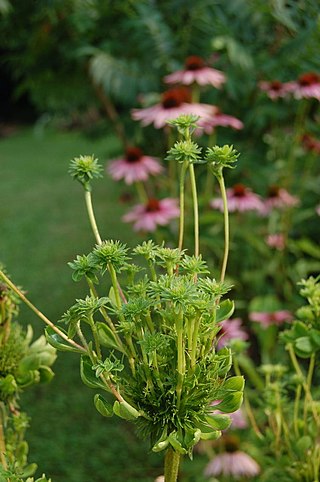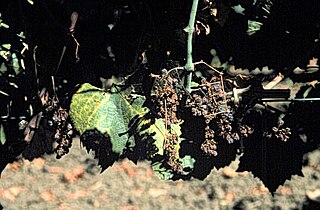
Witch's broom or witches' broom is a deformity in a woody plant, typically a tree, where the natural structure of the plant is changed. A dense mass of shoots grows from a single point, with the resulting structure resembling a broom or a bird's nest. It is sometimes caused by pathogens.

Phytoplasmas are obligate intracellular parasites of plant phloem tissue and of the insect vectors that are involved in their plant-to-plant transmission. Phytoplasmas were discovered in 1967 by Japanese scientists who termed them mycoplasma-like organisms. Since their discovery, phytoplasmas have resisted all attempts at in vitro culture in any cell-free medium; routine cultivation in an artificial medium thus remains a major challenge. Phytoplasmas are characterized by the lack of a cell wall, a pleiomorphic or filamentous shape, a diameter normally less than 1 μm, and a very small genome.

Acholeplasmataceae is a family of bacteria. It is the only family in the order Acholeplasmatales, placed in the class Mollicutes. The family comprises the genera Acholeplasma and Phytoplasma. Phytoplasma has the candidatus status, because members still could not be cultured.

Leptosphaeria sacchari is a plant pathogenic fungus which causes a disease called ring spot on Saccharum officinarum. This species was originally described in 1890 by Kruger and in 1892 by Van Breda de Haan after it was discovered in the Dominican Republic. L. sacchari is the applied name, whereas Epicoccum sorghinum is the accepted name.
Fusarium sacchari is a fungal and plant pathogen of crops including sugarcane in China.

Bipolaris sacchari is a fungal plant pathogen in the family Pleosporaceae.

Sugarcane or sugar cane is a species of tall, perennial grass that is used for sugar production. The plants are 2–6 m (6–20 ft) tall with stout, jointed, fibrous stalks that are rich in sucrose, which accumulates in the stalk internodes. Sugarcanes belong to the grass family, Poaceae, an economically important flowering plant family that includes maize, wheat, rice, and sorghum, and many forage crops. It is native to the warm temperate and tropical regions of India, Southeast Asia, and New Guinea. Grown in tropical and subtropical regions, sugarcane is the world's largest crop by production quantity, totaling 1.9 billion tonnes in 2020, with Brazil accounting for 40% of the world total. Sugarcane accounts for 79% of sugar produced globally. About 70% of the sugar produced comes from Saccharum officinarum and its hybrids. All sugarcane species can interbreed, and the major commercial cultivars are complex hybrids.

Zebra chip, also known as papa manchada and papa rayada, is a disease in potatoes putatively caused by an alphaproteobacterium "Candidatus Liberibacter solanacearum", which is vectored by the potato psyllid. When fried, potato tubers from infected plants develop unsightly black lines resembling the stripes of zebras that render the chips unsellable. Additionally, striped sections of chips frequently burn and caramelize, resulting in a bitter flavor. No health risks have been connected with consumption of infected potato chips.

Grapevine yellows (GY) are diseases associated to phytoplasmas that occur in many grape growing areas worldwide and are of still increasing significance. The most important grapevine yellows is flavescence dorée.

Sugarcane grassy shoot disease (SCGS), is associated with 'Candidatus Phytoplasma sacchari' which are small, pleomorphic, pathogenic mycoplasma that contribute to yield losses from 5% up to 20% in sugarcane. These losses are higher in the ratoon crop. A higher incidence of SCGS has been recorded in some parts of Southeast Asia and India, resulting in 100% loss in cane yield and sugar production.
Deltocephalus is a leafhopper genus in the subfamily Deltocephalinae.

"Candidatus Phytoplasma solani" is a phytopathogenic bacterial Phytoplasma species of the 16SrXII group, the causal agent of the black wood of grapevine. The black wood of grapevine disease is classified as part of the grapevine yellows.

CandidatusPhytoplasma fraxini is a species of phytoplasma, a specialized group of bacteria which lack a cell wall and attack the phloem of plants. This phytoplasma causes the diseases ash yellows and lilac witches' broom.
Kishan Singh is an Indian plant pathologist, known for his contributions to the pathology of crops, especially sugarcane. An alumnus of the Chandra Shekhar Azad University of Agriculture and Technology, he is reported to have done seminal research on the epidemiology and control of sugarcane diseases and suggested disease management through hot air therapy. He has published his research findings by way of articles and books, which include Soil fungicides, Recent advances in plant pathology, The national research grid for sugarcane in India, Sugarcane diseases and prospects of their control, Diseases of sugarbeet in India, Grassy shoot disease of sugarcane : III: response of varieties to infection, Innovations in companion cropping with sugarcane and Laminar infection of sugarcane leaves by red rot organism in nature. The Council of Scientific and Industrial Research, the apex agency of the Government of India for scientific research, awarded him the Shanti Swarup Bhatnagar Prize for Science and Technology, one of the highest Indian science awards, in 1976, for his contributions to biological sciences.
The Ramu stunt disease is a disease of the sugarcane widespread throughout Papua New Guinea, but not detected in Australia. Eumetopina flavipes, the island sugarcane planthopper, is a species of planthopper present throughout South East Asia which is a vector for the disease.
Milkweed yellows phytoplasma is a strain of phytoplasma in the class Mollicutes, a class of bacteria distinguished by the absence of a cell wall. The phytoplasma strain is denoted by the acronym MW1.
Candidatus Phytoplasma pruni is a species of phytoplasma in the class Mollicutes, a class of bacteria distinguished by the absence of a cell wall. The specific epithet pruni means "living on Prunus", emphasizing the fact that the phytoplasma is a parasite of various Prunus species, otherwise known as stone fruits. The phytoplasma is commonly called the X-disease phytoplasma.
Candidatus Phytoplasma palmicola is a phytoplasma first detected in Mozambique in 2007. A symptomology similar to coconut lethal yellowing disease (LYD) was found. This same disease was then found in Côte d’Ivoire. It was discovered by Harrison et al., 2014 to be due to a species nova which they named Candidatus Phytoplasma palmicola and assigned to novel Candidatus Phytoplasma subgroup 16SrXXII-B.










